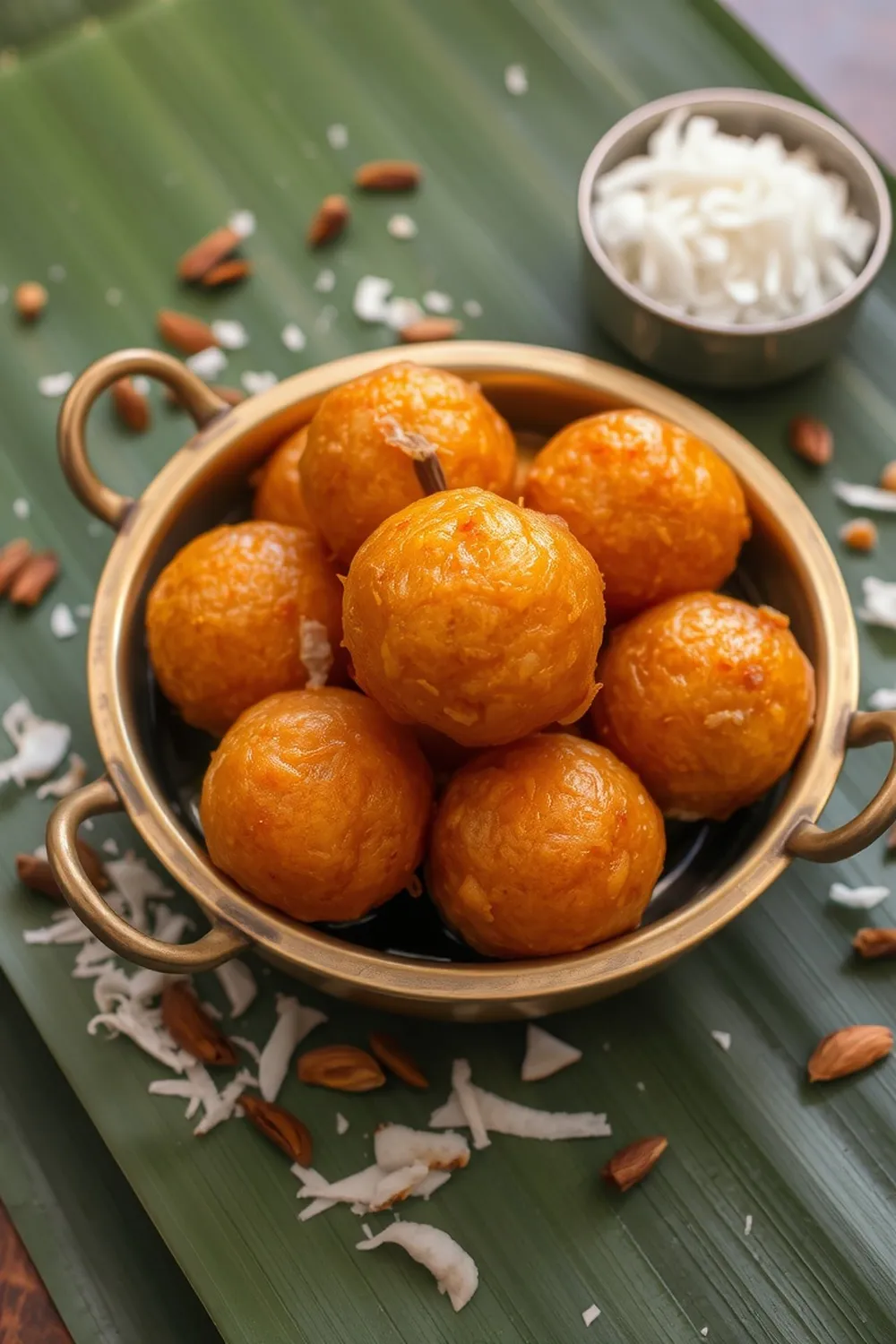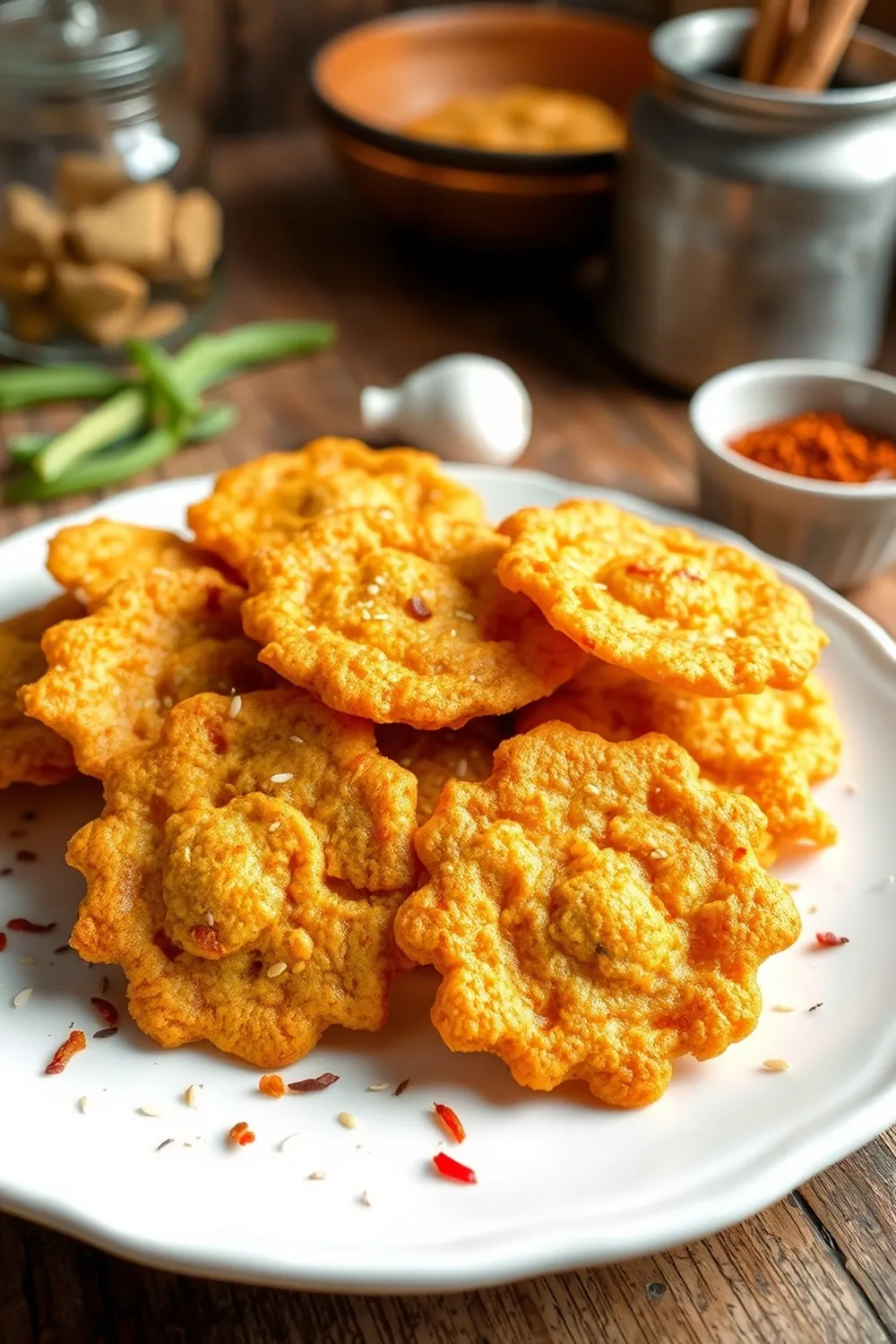- Heat oil for deep-frying in a pan to 350°F (175°C).
- In a mixing bowl, combine all-purpose flour, carom seeds, and salt.
- Add ghee to the dry ingredients and mix well with your fingertips until the flour resembles breadcrumbs.
- Gradually add water while kneading to form a stiff dough (firmer than chapati dough). The dough should not be sticky.
- Lightly grease the dough ball with oil or ghee, cover, and let it rest for at least 30 minutes.
- Lightly grease a rolling surface and rolling pin with oil or ghee.
- Divide the dough into small portions and roll each into a thin square or round shape (slightly thicker than chapati).
- Use a knife or pastry cutter to cut the rolled dough into diamond, square, or rectangular shapes.
- Carefully drop the pieces into hot oil and fry on medium-low heat until golden brown and crisp.
- Flip the namak pare midway through frying for even cooking.
- Remove fried pieces and drain excess oil on paper towels.
- Sprinkle chaat masala while still warm for extra flavor.
- Serve immediately for a soft texture or let cool completely for crispiness.
- Store cooled namak pare in an airtight container at room temperature for up to a week.
- Calories:150 kcal25%
- Energy:627 kJ22%
- Protein:2 g28%
- Carbohydrates:18 mg40%
- Sugar:mg8%
- Salt:200 g25%
- Fat:8 g20%
Last Updated on 4 months by Neha Deshmukh
Authentic Namak Pare Recipe – Ajwain & Ghee Flavored Indian Snack
Hey everyone! If you’ve ever spent an afternoon at an Indian home during a festival or just a cozy weekend, chances are you’ve stumbled upon a plate of these delightful, savory bites – Namak Pare! They’re seriously addictive, and honestly, I can’t resist making a batch whenever I’m craving something crunchy and flavorful. I first made these with my grandmother, and it’s a memory I cherish. Today, I’m sharing my go-to recipe with you, so you can experience the joy of homemade Namak Pare too!
Why You’ll Love This Recipe
This Namak Pare recipe is all about simple ingredients and maximum flavor. The combination of ajwain (carom seeds) and ghee gives it a unique, comforting taste that’s just so Indian. It’s a relatively easy recipe, perfect for beginners, and the result is a batch of crispy, savory snacks that everyone will love. Plus, it’s a fantastic way to impress your friends and family!
Ingredients
Here’s what you’ll need to make a batch of these golden beauties:
- 1 cup All Purpose Flour (120g)
- 0.25 tsp Carom Seeds (Ajwain) (approx. 1.25g)
- 0.5 tsp Salt (approx. 2.5g)
- 2 tbsp Clarified Butter (Ghee) (30ml)
- 0.25 cup Water (60ml)
- Oil for deep frying
Ingredient Notes
Let’s talk ingredients! Getting these right will make all the difference.
All Purpose Flour: This is the base of our Namak Pare. You can also experiment with whole wheat flour for a slightly healthier version, but all-purpose flour gives the most authentic texture. If you’re gluten-free, I’ve included a variation later on!
Carom Seeds (Ajwain): Don’t skip these! Ajwain isn’t just about flavor; it’s also known for its digestive properties. It adds a lovely, slightly pungent aroma and taste that’s characteristic of Namak Pare.
Clarified Butter (Ghee): Ghee is traditional and adds a richness you just can’t replicate. You can use store-bought ghee, but homemade ghee is always best if you have the time. It really elevates the flavor.
Oil for Deep Frying: Any neutral-flavored oil with a high smoke point will work. Sunflower oil, vegetable oil, or canola oil are all good choices. I prefer sunflower oil for its mild flavor.
Regional Variations in Namak Pare: You’ll find that every family has their own little twist on Namak Pare! Some add a pinch of turmeric for color, while others include a bit of chili powder for a spicy kick. Feel free to experiment and make it your own.
Step-By-Step Instructions
Alright, let’s get cooking!
- First, heat the oil for deep-frying in a pan over medium-low heat. We want it hot enough to fry, but not so hot that it burns the Namak Pare.
- In a mixing bowl, combine the all-purpose flour, carom seeds, and salt. Give it a good mix.
- Now, add the ghee to the dry ingredients. This is the fun part – use your fingertips to rub the ghee into the flour until it resembles breadcrumbs. This step is key for a flaky texture!
- Gradually add water, a little at a time, while kneading to form a stiff dough. It should be firmer than chapati dough – this is important!
- Lightly grease the dough ball with a little oil or ghee. Cover it and let it rest for about 5 minutes. This allows the gluten to relax, making the dough easier to roll.
- Grease your rolling surface and rolling pin with oil. This prevents the dough from sticking.
- Divide the dough into small portions. Roll each portion into a thin square or round shape – slightly thicker than a chapati.
- Using a greased knife, cut the rolled dough into diamond-shaped pieces. Don’t worry about making them perfect; rustic is charming!
- Carefully drop the diamond pieces into the hot oil, a few at a time. Fry them on medium-low heat until they turn golden brown.
- Flip the Namak Pare midway through for even cooking.
- Remove the fried pieces and drain them on paper towels to remove excess oil.
- While they’re still warm, sprinkle with chaat masala for an extra burst of flavor.
- Serve immediately for a soft texture, or let them cool completely for a satisfying crunch.
Expert Tips
Here are a few things I’ve learned over the years to make the perfect Namak Pare:
Achieving the Perfect Dough Consistency: The dough needs to be firm. If it’s too soft, the Namak Pare will absorb too much oil.
Frying Temperature Control: Medium-low heat is your friend. If the oil is too hot, the Namak Pare will brown quickly on the outside but remain uncooked inside.
Ensuring Even Cooking: Don’t overcrowd the pan. Fry in batches to maintain the oil temperature.
Getting the Right Texture: Soft vs. Crispy: Freshly fried Namak Pare is softer. Letting them cool completely will give you that signature crispiness.
Variations
Want to switch things up? Here are a few ideas:
Vegan Namak Pare: Substitute the ghee with an equal amount of vegan butter or vegetable oil.
Gluten-Free Namak Pare (Using Besan or Rice Flour): Replace the all-purpose flour with besan (gram flour) or rice flour. You might need to adjust the amount of water.
Spice Level Adjustments (Adding Chili Powder): Add a pinch of chili powder to the dough for a spicy kick. My friend loves adding a dash of cayenne pepper!
Festival Adaptations (Diwali, Holi): During Diwali, I sometimes add a little bit of edible silver leaf (varak) for a festive touch.
Serving Suggestions
Namak Pare is perfect as a standalone snack with a cup of chai. It’s also a great accompaniment to a meal, or you can pack it for picnics and road trips. My kids love them in their lunchboxes!
Storage Instructions
Once cooled completely, store the Namak Pare in an airtight container at room temperature. They’ll stay fresh and crispy for up to a week (if they last that long!).
FAQs
Let’s answer some common questions:
What is the secret to making Namak Pare extra crispy? Frying at the right temperature and letting them cool completely are key!
Can I make the dough ahead of time? Yes, you can! Just wrap it tightly in plastic wrap and refrigerate for up to 2 days.
What can I substitute for ghee in this recipe? You can use vegetable oil or vegan butter, but the flavor won’t be quite the same.
How do I prevent the Namak Pare from absorbing too much oil? Make sure the dough is firm and the oil isn’t too hot.
Is it possible to bake Namak Pare instead of frying? While frying is traditional, you can bake them at 180°C (350°F) for about 15-20 minutes, flipping halfway through. They won’t be as crispy, though.
What is the significance of Ajwain in Namak Pare? Ajwain adds a unique flavor and is believed to aid digestion, making it a comforting and wholesome snack.
Enjoy making (and eating!) these delicious Namak Pare. Let me know how they turn out in the comments below!










